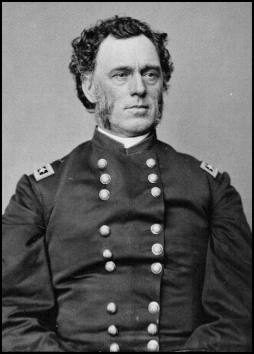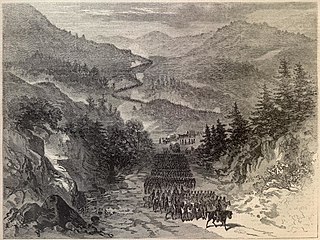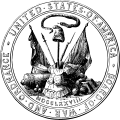
The Army of the Tennessee was a Union army in the Western Theater of the American Civil War, named for the Tennessee River.
IX Corps was a corps of the Union Army during the American Civil War that distinguished itself in combat in multiple theaters: the Carolinas, Virginia, Kentucky, Tennessee, and Mississippi.

XXIII Corps was a corps of the Union Army during the American Civil War. It served in the Western Theater as part of the Army of the Ohio.

The western theater of the American Civil War encompassed major military operations in the states of Alabama, Georgia, Florida, Mississippi, North Carolina, Kentucky, South Carolina and Tennessee, as well as Louisiana east of the Mississippi River. Operations on the coasts of these states, except for Mobile Bay, are considered part of the Lower Seaboard Theater. Most other operations east of the Appalachian Mountains are part of the eastern theater. Operations west of the Mississippi River took place in the trans-Mississippi theater.
The Department of the Ohio was an administrative military district created by the United States War Department early in the American Civil War to administer the troops in the Northern states near the Ohio River.

The 104th Ohio Infantry Regiment, sometimes 104th Ohio Volunteer Infantry, was an infantry regiment in the Union army during the American Civil War. It played a conspicuous role at the Battle of Franklin during the 1864 Franklin–Nashville campaign, where six members later received the Medal of Honor, most for capturing enemy flags.

The Knoxville campaign was a series of American Civil War battles and maneuvers in East Tennessee during the fall of 1863 designed to secure control of the city of Knoxville and with it the railroad that linked the Confederacy east and west, and position the First Corps under Longstreet for return to the Army of Northern Virginia. Union Army forces under Maj. Gen. Ambrose Burnside occupied Knoxville, Tennessee, and Confederate States Army forces under Lt. Gen. James Longstreet were detached from Gen. Braxton Bragg's Army of Tennessee at Chattanooga to prevent Burnside's reinforcement of the besieged Federal forces there. Ultimately, Longstreet's Siege of Knoxville ended when Union Maj. Gen. William Tecumseh Sherman led elements of the Army of the Tennessee and other troops to Burnside's relief after Union troops had broken the Confederate siege of Chattanooga. Although Longstreet was one of Gen. Robert E. Lee's best corps commanders in the East in the Army of Northern Virginia, he was unsuccessful in his attempt to penetrate the Knoxville defenses and take the city.

James Blair Steedman was an American printer, contractor and lawyer who rose to the rank of general in the Union Army during the Civil War. A printer by trade, as well as a soldier during the Texas War of Independence, Steedman returned to Ohio and later became a delegate in the state's General Assembly as well as President of Public Works, although he lost his campaign to become a U.S. Congressman.

The September 7–9, 1863 fall of the Cumberland Gap was a victory for Union forces under the command of Ambrose Burnside during his campaign for Knoxville. The bloodless engagement cost the Confederates 2,300 men captured and control of the Cumberland Gap.

James William Reilly was a lawyer, politician, and soldier from the state of Ohio who served as a general in the Union Army during the American Civil War. He commanded a brigade and then a division in the Army of the Ohio in several campaigns in the Western Theater of operations.
The 27th Kentucky Infantry Regiment was an infantry regiment that served in the Union Army during the American Civil War.
The 11th Kentucky Infantry Regiment was an infantry regiment that served in the Union Army during the American Civil War.

The 24th Kentucky Infantry Regiment was an infantry regiment that served in the Union Army during the American Civil War.
The 1st Kentucky Cavalry Regiment was a cavalry regiment that served in the Union Army during the American Civil War.
The 12th Kentucky Infantry Regiment was an infantry regiment that served in the Union Army during the American Civil War.
The 80th Regiment Indiana Infantry was an infantry regiment that served in the Union Army during the American Civil War.
The 58th Regiment Indiana Infantry was an infantry regiment that served in the Union Army during the American Civil War.
Battery D, 1st Ohio Light Artillery was an artillery battery that served in the Union Army during the American Civil War.
15th Indiana Battery Light Artillery was an artillery battery that served in the Union Army during the American Civil War.
The 107th Illinois Volunteer Infantry Regiment was raised as part of the call for 300,000 volunteers in the summer and fall of 1862. It was organized on September 4, 1862, at Camp Butler near Springfield, Illinois, and was composed of men from DeWitt, Piatt, and Williamson Counties in central and southern Illinois.










